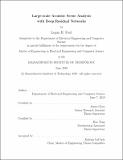| dc.contributor.advisor | James Glass and Hao Tang. | en_US |
| dc.contributor.author | Ford, Logan H. | en_US |
| dc.contributor.other | Massachusetts Institute of Technology. Department of Electrical Engineering and Computer Science. | en_US |
| dc.date.accessioned | 2019-11-22T00:03:03Z | |
| dc.date.available | 2019-11-22T00:03:03Z | |
| dc.date.copyright | 2019 | en_US |
| dc.date.issued | 2019 | en_US |
| dc.identifier.uri | https://hdl.handle.net/1721.1/123026 | |
| dc.description | This electronic version was submitted by the student author. The certified thesis is available in the Institute Archives and Special Collections. | en_US |
| dc.description | Thesis: M. Eng., Massachusetts Institute of Technology, Department of Electrical Engineering and Computer Science, 2019 | en_US |
| dc.description | Cataloged from student-submitted PDF version of thesis. | en_US |
| dc.description | Includes bibliographical references (pages 63-66). | en_US |
| dc.description.abstract | Many of the recent advances in audio event detection, particularly on the AudioSet dataset, have focused on improving performance using the released embeddings produced by a pre-trained model. In this work, we instead study the task of training a multi-label event classifier directly from the audio recordings of AudioSet. Using the audio recordings, not only are we able to reproduce results from prior work, we have also confirmed improvements of other proposed additions, such as an attention module. Moreover, by training the embedding network jointly with the additions, we achieve a mean Average Precision (mAP) of 0.392 and an area under ROC curve (AUC) of 0.971, surpassing the state-of-the-art without transfer learning from a large dataset. We also analyze the output activations of the network and find that the models are able to localize audio events when a finer time resolution is needed. In addition, we use this model in exploring multimodal learning, transfer learning, and realtime sound event detection tasks. | en_US |
| dc.description.statementofresponsibility | by Logan H. Ford. | en_US |
| dc.format.extent | 66 pages | en_US |
| dc.language.iso | eng | en_US |
| dc.publisher | Massachusetts Institute of Technology | en_US |
| dc.rights | MIT theses are protected by copyright. They may be viewed, downloaded, or printed from this source but further reproduction or distribution in any format is prohibited without written permission. | en_US |
| dc.rights.uri | http://dspace.mit.edu/handle/1721.1/7582 | en_US |
| dc.subject | Electrical Engineering and Computer Science. | en_US |
| dc.title | Large-scale acoustic scene analysis with deep residual networks | en_US |
| dc.type | Thesis | en_US |
| dc.description.degree | M. Eng. | en_US |
| dc.contributor.department | Massachusetts Institute of Technology. Department of Electrical Engineering and Computer Science | en_US |
| dc.identifier.oclc | 1127649352 | en_US |
| dc.description.collection | M.Eng. Massachusetts Institute of Technology, Department of Electrical Engineering and Computer Science | en_US |
| dspace.imported | 2019-11-22T00:03:02Z | en_US |
| mit.thesis.degree | Master | en_US |
| mit.thesis.department | EECS | en_US |
